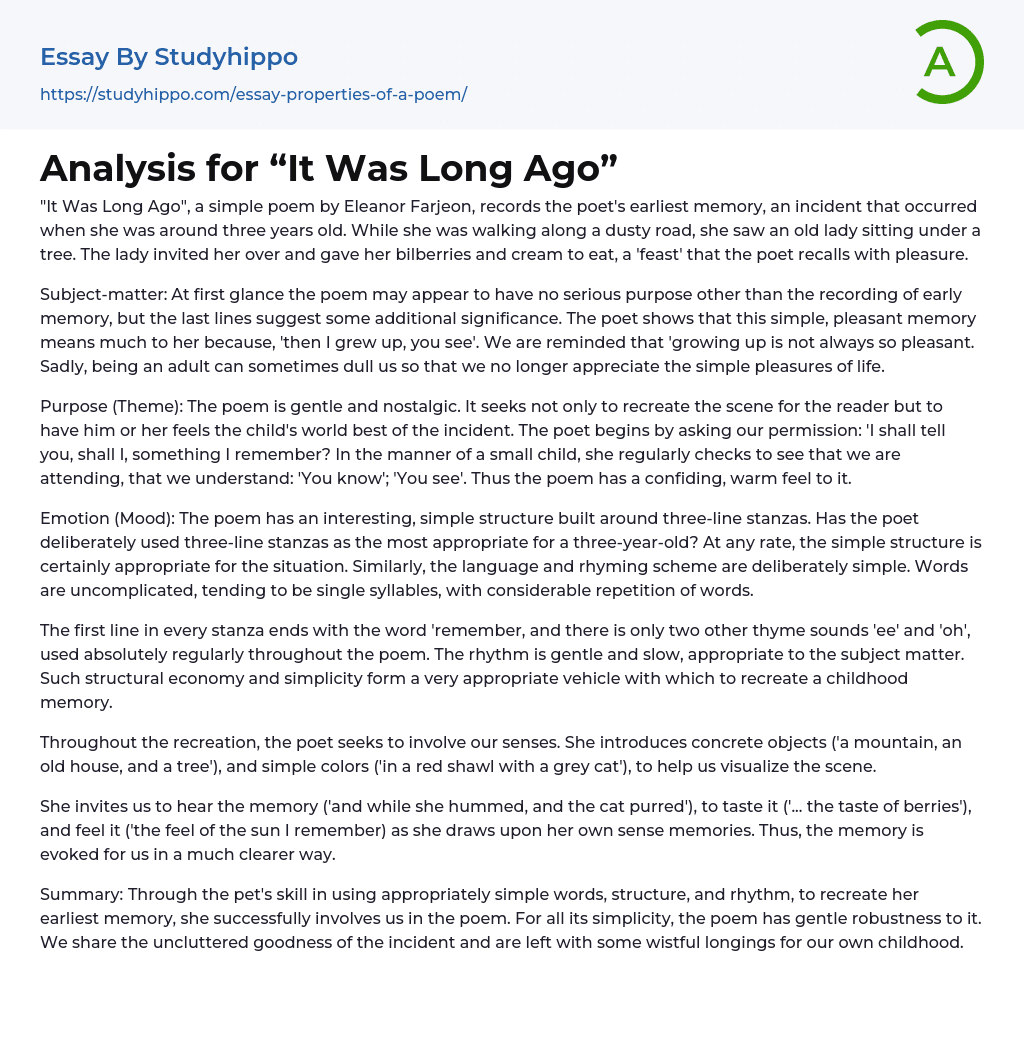"It Was Long Ago", a simple poem by Eleanor Farjeon, records the poet's earliest memory, an incident that occurred when she was around three years old. While she was walking along a dusty road, she saw an old lady sitting under a tree. The lady invited her over and gave her bilberries and cream to eat, a 'feast' that the poet recalls with pleasure.
Subject-matter: At first glance the poem may appear to have no serious purpose other than the recording of early memory, but the last lines suggest some additional significance. The poet shows that this simple, pleasant memory means much to her because, 'then I grew up, you see'. We are reminded that 'growing up is not always so pleasant. Sadly, being an adult can sometimes dull us so that we no longer appreciate the simple pleasure
...s of life.
Purpose (Theme): The poem is gentle and nostalgic. It seeks not only to recreate the scene for the reader but to have him or her feels the child's world best of the incident. The poet begins by asking our permission: 'I shall tell you, shall I, something I remember? In the manner of a small child, she regularly checks to see that we are attending, that we understand: 'You know'; 'You see'. Thus the poem has a confiding, warm feel to it.
Emotion (Mood): The poem has an interesting, simple structure built around three-line stanzas. Has the poet deliberately used three-line stanzas as the most appropriate for a three-year-old? At any rate, the simple structure is certainly appropriate for the situation. Similarly, the language and rhyming scheme ar
deliberately simple. Words are uncomplicated, tending to be single syllables, with considerable repetition of words.
The first line in every stanza ends with the word 'remember, and there is only two other thyme sounds 'ee' and 'oh', used absolutely regularly throughout the poem. The rhythm is gentle and slow, appropriate to the subject matter. Such structural economy and simplicity form a very appropriate vehicle with which to recreate a childhood memory.
Throughout the recreation, the poet seeks to involve our senses. She introduces concrete objects ('a mountain, an old house, and a tree'), and simple colors ('in a red shawl with a grey cat'), to help us visualize the scene.
She invites us to hear the memory ('and while she hummed, and the cat purred'), to taste it ('... the taste of berries'), and feel it ('the feel of the sun I remember) as she draws upon her own sense memories. Thus, the memory is evoked for us in a much clearer way.
Summary: Through the pet's skill in using appropriately simple words, structure, and rhythm, to recreate her earliest memory, she successfully involves us in the poem. For all its simplicity, the poem has gentle robustness to it. We share the uncluttered goodness of the incident and are left with some wistful longings for our own childhood.
- Boo Radley essays
- Genesis essays
- Richard iii essays
- Alice in Wonderland essays
- On the road essays
- Ozymandias essays
- The Nightingale essays
- Holden Caulfield essays
- Animal Farm essays
- 1984 essays
- A Hanging essays
- Shooting An Elephant essays
- A Tale Of Two Cities essays
- Adventures Of Huckleberry Finn essays
- Arthur Conan Doyle essays
- Brave New World essays
- Characters In Hamlet essays
- Characters In Romeo And Juliet essays
- Desdemona essays
- Diary Of A Wimpy Kid essays
- First-Person Narrative essays
- Frankenstein essays
- Heart Of Darkness essays
- Jane Eyre essays
- Jay Gatsby essays
- King Duncan essays
- Librarian essays
- Little Red Riding Hood essays
- Lord Of The Flies essays
- Silas Marner essays
- The Cask Of Amontillado essays
- The Catcher In The Rye essays
- The Crucible essays
- The Handmaid's Tale essays
- The Reader essays
- Virgil essays
- Wuthering Heights essays
- Candide essays
- Castle essays
- J. D. Salinger essays
- Ulysses essays
- Ethan Frome essays
- In Cold Blood essays
- Outliers essays
- Tuesdays With Morrie essays
- The Art of War essays
- Wife of Bath essays
- Huckleberry Finn essays
- The Lady With The Dog essays
- Great Expectations essays




